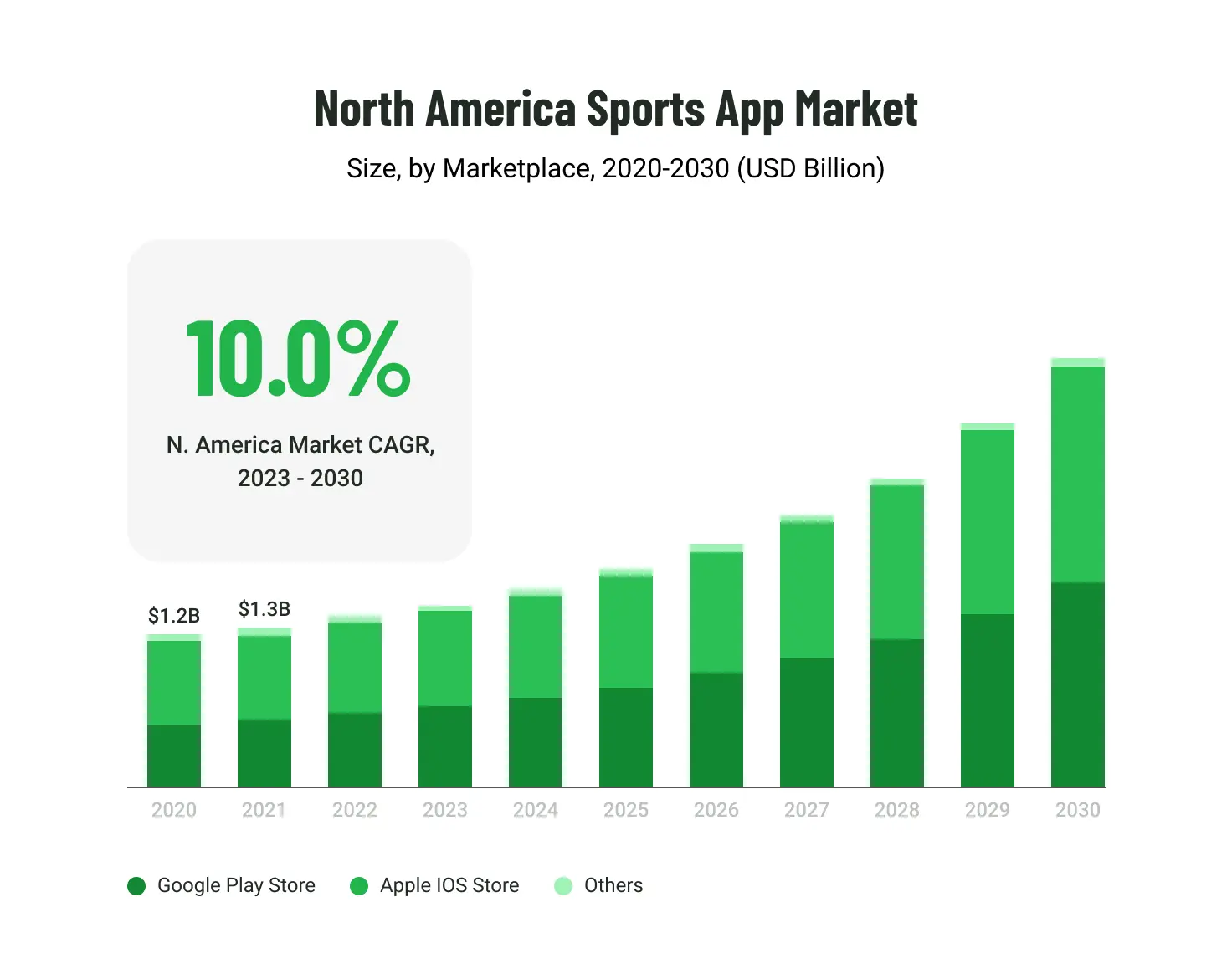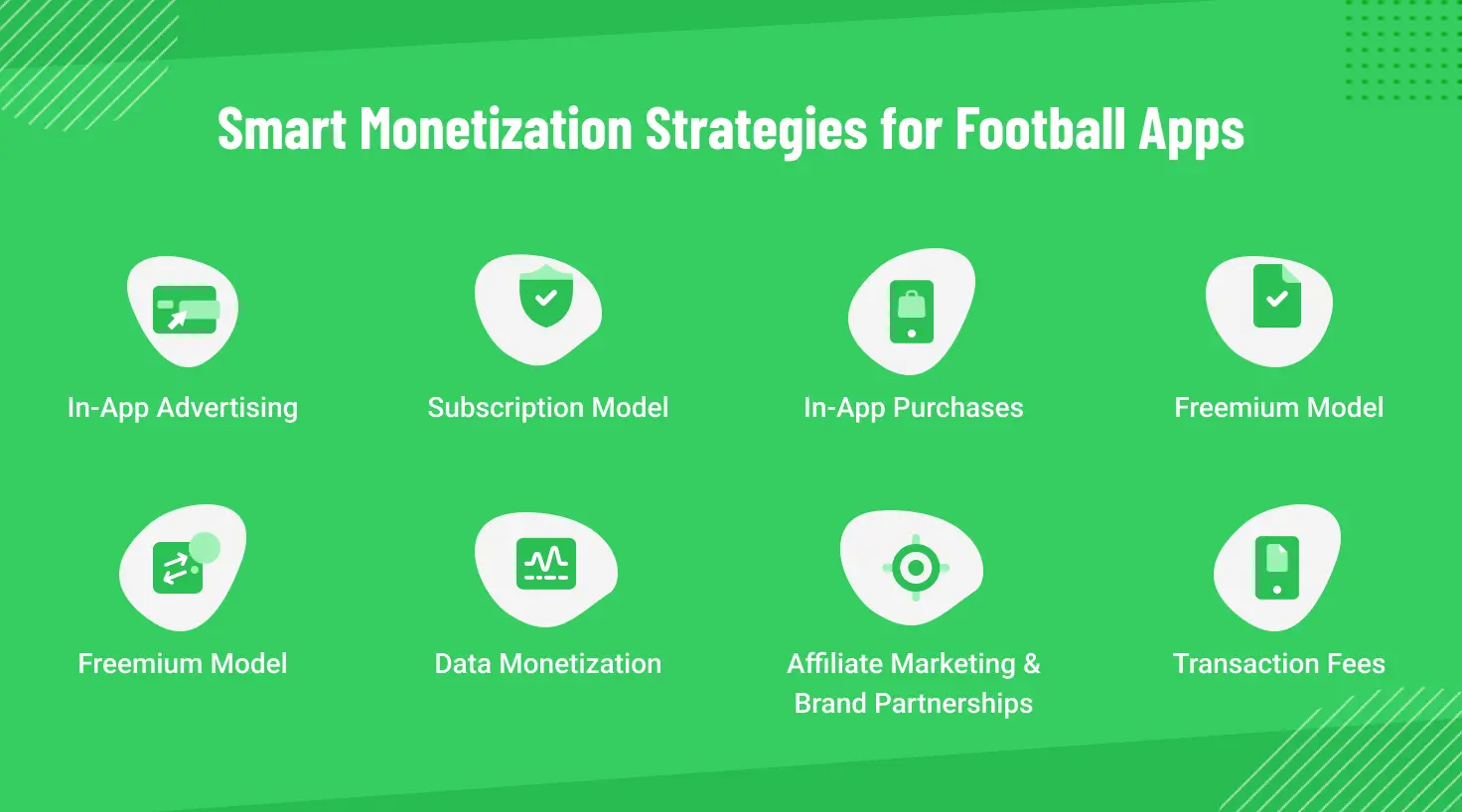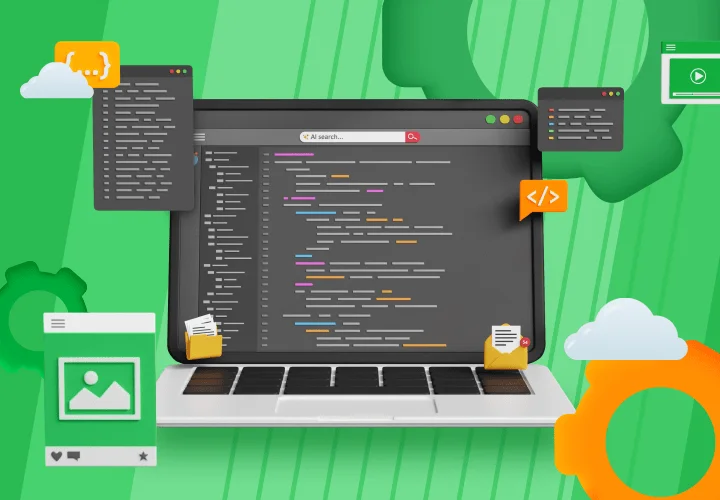Hitting the Back of the Net: Winning Big in Football App Development
Table of contents
- Knowing Your Users: Understanding the Modern Football Fan
- Types of Mobile Applications for Football
- Live score and news apps
- Fantasy football apps
- Other specialized football apps
- Key Features That Make Football Apps a Hit with Fans
- Live scores, instant match updates & in-game stats
- Comprehensive news & smart content feeds
- Player & team deep dives
- League tables & upcoming fixtures
- Smart notifications that actually matter
- Fantasy football features
- Social tools & fan communities
- Highlights, replays & on-demand video
- Next-level features that set apps apart
- Why Football Fans Love Mobile Apps
- Deeper engagement, anytime
- Always-on access
- Community & connection
- A personalized football hub
- Strategic thinking for fantasy players
- Exclusive tools & next-gen analytics
- Smart Monetization Strategies for Football Apps
- 1. In-app advertising
- 2. Subscription model
- 3. In-app purchases (IAP)
- 4. Freemium model
- 5. Entry fees & prize pools (fantasy football apps)
- 6. Data monetization (with consent)
- 7. Affiliate marketing & brand partnerships
- 8. Transaction fees
- Choosing the right model
- Trends Shaping the Future of Football App Development
- 1. Artificial intelligence & machine learning
- 2. Augmented reality (AR) & virtual reality (VR)
- 3. Integration with wearable devices
- 4. Blockchain and NFTs
- 5. Enhanced social and community features
- 6. Hyper-personalization and context awareness
- Challenges in Football App Development: What to Watch Out For
- 1. Data accuracy & integrity
- 2. Scalability during peak loads
- 3. Data privacy and security
- 4. Monetization without compromising UX
- 5. User retention in a competitive market
- 6. Content licensing and rights management
- 7. Android fragmentation
- Looking ahead
- Conclusion
The global market for sports mobile applications was estimated at approximately $3.66 billion in 2022 and is expected to expand steadily, with a projected compound annual growth rate (CAGR) of around 10.9% through 2030. The United States is set to play a key role in driving market growth, fueled by a strong demand for intuitive and user-friendly digital sports platforms.

With football’s unmatched global popularity and a massive fanbase, the demand for mobile sports apps is booming. As smartphones become the go-to source for news, entertainment, and social connection, football fans increasingly rely on apps to follow matches live, get real-time updates, and connect with fellow supporters.
Thanks to advancements in AI, augmented and virtual reality, and integration with wearables, football apps are becoming more immersive and intelligent — offering features that once felt futuristic.
The market spans a wide array of app types, from live score trackers and news feeds to fantasy leagues, fan communities, and team management platforms. Each caters to different fan interests and use cases.
Knowing Your Users: Understanding the Modern Football Fan
Before developing a football app, it’s critical to define your target audience. Football fans range from casual followers and die-hard club supporters to fantasy league players, amateur athletes, and coaches. Each group has specific needs — from quick updates and social features to performance analytics and strategic tools.
Some fans want breaking news and live scores; others crave interaction, personalized content, or tools to enhance their game. The most successful apps solve real user problems — offering centralized, reliable information, fantasy team management, or even matchmaking for pickup games.
Equally important is user experience. A sleek design, intuitive navigation, and fast, responsive performance aren’t optional — they’re essential for building loyalty and standing out in a competitive market.
Types of Mobile Applications for Football
The mobile football app market encompasses a wide variety of solutions, each designed to meet specific user needs and cater to different fan segments.
Live score and news apps
Among the most popular football-related apps, live score and news platforms deliver real-time updates on ongoing matches, including live scores, key events (goals, red cards, injuries), and in-depth statistics. These apps often go beyond live coverage to offer match previews, post-game analysis, league standings, team lineups, and customizable notifications. For fans wanting to stay informed on the go, these apps serve as an essential daily companion.
Fantasy football apps
Fantasy football platforms allow users to create virtual teams composed of real-life players, scoring points based on the athletes’ actual performances. These apps typically feature player drafts, team management tools, live performance tracking, and head-to-head competitions. Rich in statistics and designed for deep user engagement, fantasy apps also foster social interaction through leagues, chats, and leaderboards.
Other specialized football apps
In addition to the mainstream categories, several niche football applications address more specific use cases:
- Pitch finder apps: Help users locate nearby football fields, view surface type, availability, and ratings, and book playing time directly through the app.
- Virtual football games: Provide immersive gaming experiences using augmented or virtual reality to simulate football matches.
- Training and performance apps: Offer guided workouts, tactical drills, and performance analytics for players at all levels.
- Football E-commerce platforms: Enable fans to purchase team merchandise, football gear, and match tickets, often with integrated loyalty programs or exclusive offers.
Key Features That Make Football Apps a Hit with Fans
What separates a good football app from a great one? It’s all about features that deliver real-time value, keep users engaged, and turn casual fans into loyal communities. Here’s what today’s most successful apps are doing right:
Live scores, instant match updates & in-game stats
For football fans, timing is everything. That’s why real-time updates — goals, red cards, substitutions — are non-negotiable. Pair that with rich in-game stats like possession, shots on target, and fouls, and you’ve got a second-screen experience fans can’t live without. Bonus points for live commentary and minute-by-minute text feeds — perfect for fans who can’t stream the match but still want to feel every moment.
Comprehensive news & smart content feeds
Today’s fans don’t just follow scores — they follow stories. From transfer rumors and injury updates to expert commentary and match previews, users expect a steady stream of fresh, relevant content. Even better? Let them customize what they see — whether it’s just their favorite team or updates across multiple leagues.
Player & team deep dives
Fans want more than just names on a lineup — they want the full picture. Think detailed player stats, bios, recent form, and even video highlights. Add team profiles with match history, standings, and tactical breakdowns, and you’ve got a resource fans will return to again and again.
League tables & upcoming fixtures
No football app is complete without real-time standings and detailed match schedules. Whether it’s Champions League or a local league, fans want to know where their team stands — and when they play next.
Smart notifications that actually matter
Well-timed, personalized push alerts can turn a casual user into a daily one. Let users choose the teams, leagues, or types of events they care about — then keep them in the loop without overwhelming them.
Fantasy football features
Fantasy leagues aren’t just games — they’re part of the lifestyle. Apps that offer built-in fantasy experiences or integrate with popular platforms give fans the chance to put their football IQ to the test. Live scoring, player comparisons, and league chat features make the experience even more immersive.
Social tools & fan communities
Football is better together. Give fans ways to connect, whether it’s chatting with friends during a match, joining fantasy leagues, or sharing hot takes on social media. Forums, group chats, and comment sections help build a thriving community right inside your app.
Highlights, replays & on-demand video
Missed the game? No problem. Instant access to highlight reels, key moments, or even full replays gives fans a way to catch up without spoilers. If you’ve got this right, video content can be a major engagement booster.
Next-level features that set apps apart
Modern fans expect more than just the basics. Here’s how cutting-edge apps are upping their game:
- AI-powered insights & predictions: from performance forecasts to smart content suggestions, AI makes your app feel smarter and more personalized.
- Augmented reality layers: imagine pointing your camera at the screen and seeing live stats overlaid — or simulating plays in 3D. That’s the power of AR.
- Gamification: leaderboards, badges, challenges — turn every interaction into a reward and drive consistent engagement.
Why Football Fans Love Mobile Apps
Mobile football apps do more than deliver information — they transform how fans experience the sport. Here’s why they’ve become essential:
Deeper engagement, anytime
Apps go beyond scores. They offer interactive features, real-time personalization, and immersive experiences that bring fans closer to the action. Whether it’s playing fantasy football or debating the weekend’s best goal, users stay involved all week long.
Always-on access
Need match results while commuting? Looking for injury updates during halftime? Mobile apps put the entire football universe in your pocket — accessible 24/7, wherever you are.
Community & connection
Football is global but fandom is personal. Apps that include chat, forums, and social sharing
A personalized football hub
The ability to tailor alerts, news, and content transforms apps into personal football dashboards. Users stay focused on what matters most to them — no clutter, no distractions.
Strategic thinking for fantasy players
For fantasy football lovers, these apps double as strategic tools. They track stats, offer performance insights, and help users build smarter lineups, boosting both engagement and satisfaction.
Exclusive tools & next-gen analytics
From AI-driven scouting reports to immersive AR match previews, modern football apps give fans access to features they won’t find anywhere else, elevating their experience beyond traditional media.
Smart Monetization Strategies for Football Apps
Creating a compelling football app is just the beginning. Turning that app into a sustainable business requires a well-thought-out monetization strategy. Here are the most effective and commonly used revenue models that can help football apps generate real returns while keeping users engaged and satisfied.

1. In-app advertising
One of the most straightforward revenue streams, in-app ads can deliver strong ROI — especially for apps with high user traffic. This includes formats like:
- Banner ads
- Interstitials (ads that appear between content)
- Rewarded video ads
The key is balance. Ads should be seamlessly integrated so they don’t interrupt the user experience. Thoughtful placement can keep engagement high and revenue steady.
2. Subscription model
Recurring revenue? Yes, please. Offering a subscription unlocks access to exclusive features or content and creates a predictable income stream. Common perks include:
- An ad-free experience
- Advanced statistics and analytics
- Exclusive news, behind-the-scenes content, or early access to features
- Personalized notifications and customization options
This model works particularly well for highly engaged users looking for premium value.
3. In-app purchases (IAP)
Virtual goods and one-time feature unlocks provide users with flexibility and developers with steady micro-transaction income. Ideal for:
- Fantasy football apps (e.g., team upgrades, boosts, virtual coins)
- Training apps (e.g., unlocking workouts, premium drills)
- AR/VR content (e.g., immersive match experiences or visual overlays)
4. Freemium model
The freemium model draws users in with free core features, then encourages upgrades through gated premium content. It’s a low-barrier way to build an audience and a powerful way to convert your most engaged users into paying customers.
5. Entry fees & prize pools (fantasy football apps)
In the fantasy football niche, competitive users are often willing to pay for the thrill of the game. Apps can charge:
- Entry fees for fantasy contests
- Offer real-money prize pools
- Retain a platform commission from each entry
It’s a model that not only generates revenue but increases user retention by raising the stakes.
6. Data monetization (with consent)
When done ethically and in compliance with data privacy regulations (like GDPR), anonymized data can be a valuable asset. Insights into fan behavior, preferences, and usage patterns can be sold to:
- Sports marketers
- Analytics firms
- Advertisers seeking targeted campaign opportunities
Transparency and user trust are essential for this model to succeed.
7. Affiliate marketing & brand partnerships
Strategic partnerships can open up additional revenue streams through affiliate programs. For example:
- Promoting sports merchandise or ticket sales
- Linking to betting platforms (where legally permissible)
- Offering discounts from fitness or lifestyle brands
Each conversion or purchase through the app earns a commission — an ideal model for apps with high engagement and niche audiences.
8. Transaction fees
If your app enables users to make bookings or purchases — like reserving a football field or buying matchday tickets — you can charge a small service fee. This is a particularly good fit for:
- Local game coordination apps
- Sports facility booking platforms
- E-commerce extensions within football apps
Choosing the right model
There’s no one-size-fits-all approach. The best monetization strategy depends on your app type, your users, and your business goals. In many cases, hybrid models (e.g., combining freemium access with in-app purchases and ads) can maximize both reach and revenue.
Whether you're building a live score app, a fantasy league platform, or a virtual training tool, aligning your monetization plan with user behavior is key to long-term success.
Trends Shaping the Future of Football App Development
The mobile football app landscape is rapidly evolving, driven by cutting-edge technologies and ever-changing user expectations. Here’s a look at the key trends that are redefining how fans interact with the beautiful game — and what developers should anticipate going forward.
1. Artificial intelligence & machine learning
AI and ML are no longer optional — they’re becoming essential. These technologies empower football apps to deliver smarter, more personalized experiences. Think:
- Predictive analytics based on player stats and match history
- AI-driven recommendations tailored to user behavior
- 24/7 AI chatbot support to enhance user engagement and reduce churn
By turning raw data into actionable insights, AI is helping fans make more informed decisions, whether they're managing a fantasy team or analyzing a real-life match.
2. Augmented reality (AR) & virtual reality (VR)
AR and VR are elevating how fans experience football:
- AR overlays can display live stats during match streaming or offer interactive replays
- VR experiences can transport fans to virtual stadiums, behind-the-scenes tours, or even immersive match simulations
As these technologies become more accessible, expect to see them integrated into fan engagement tools, fantasy apps, and training platforms.
3. Integration with wearable devices
Wearables are unlocking a new level of interaction for both fans and players:
- Fans can receive real-time match updates directly on smartwatches
- Amateur and professional players alike can track performance metrics during games and training
- Coaches can analyze team data collected from connected devices in real time
This fusion of health, fitness, and sports entertainment is fueling new app categories and use cases.
4. Blockchain and NFTs
Blockchain is reshaping digital ownership and fan engagement:
- NFT collectibles featuring iconic football moments
- Fan tokens offering voting rights, rewards, or exclusive content
- Secure ticketing to reduce fraud and scalping
As Web3 adoption grows, these innovations will deepen the connection between fans and their favorite teams.
5. Enhanced social and community features
Football is inherently social — and future apps will reflect that even more:
- Live match chats, comment sections, and fan polls
- User-generated content features (e.g., fan blogs, game recaps)
- Community-driven forums and local meetup tools
These elements help build loyalty, spark conversations, and turn passive viewers into active participants.
6. Hyper-personalization and context awareness
Tomorrow’s football apps will know exactly what users want, when they want it. By combining location data, user behavior, and real-time context, apps will offer:
- Localized content like nearby match listings or local club news
- Custom alerts based on specific interests or usage patterns
- Contextual UX that adapts to where and how the user is interacting with the app
This makes the experience not just smart — but meaningfully personal.
Challenges in Football App Development: What to Watch Out For
While the opportunities are exciting, there are also critical hurdles that developers must plan for.
1. Data accuracy & integrity
Football fans rely on up-to-the-second updates. Any delay or error in scores, stats, or news can erode trust quickly. Developers need:
- Reliable data providers and APIs
- Robust verification systems to cross-check feeds
- Failover strategies to handle API outages
2. Scalability during peak loads
Apps often face major traffic spikes during big matches or tournaments. Poor performance during these peak moments is a dealbreaker. To prevent it:
- Implement cloud-based infrastructure with auto-scaling
- Use CDNs and caching layers to reduce load
- Continuously monitor system health in real time
3. Data privacy and security
Football apps often process personal data—from account details to location and purchase history. To stay compliant and secure:
- Follow GDPR and CCPA best practices
- Use end-to-end encryption and tokenization
- Offer clear user consent flows for data use
4. Monetization without compromising UX
Too many ads or aggressive upsells? Users bounce. Effective monetization means:
- Balancing free and premium content
- Using non-intrusive ad formats
- Offering clear value in paid features or subscriptions
5. User retention in a competitive market
With countless sports apps vying for attention, retention is king. Successful apps:
- Launch regular content updates and features
- Provide personalized notifications and offers
- Cultivate strong communities and social interactions
6. Content licensing and rights management
Want to show match highlights or stream live games? Be ready to pay. Content rights are expensive, and securing them legally is critical. Developers should:
- Partner with official content providers or leagues
- Explore affiliate content options
- Budget realistically for licensing fees
7. Android fragmentation
The variety of devices, screen sizes, and OS versions on Android poses technical challenges. Solving this means:
- Comprehensive device testing strategies
- Adaptive UI/UX design for multiple form factors
- Continuous performance optimization
Looking ahead
The football app industry is at an exciting inflection point. As technologies like AI, AR, and blockchain mature (and user expectations rise) there’s immense potential for innovation. Developers who combine great tech with smart strategy will be the ones leading the field.
Conclusion
Football apps are becoming the ultimate playmakers in the digital stadium of sports fandom. They don’t just keep score — they create a full matchday experience right in your pocket, blending real-time action with personalized insights and social buzz. As AI, AR, and blockchain kick innovation into high gear, the apps that balance tech wizardry with smooth, fan-first design will score big. The winners in this game won’t just follow the future of football — they’ll be the ones shaping it.
Published on Jul 14, 2025





